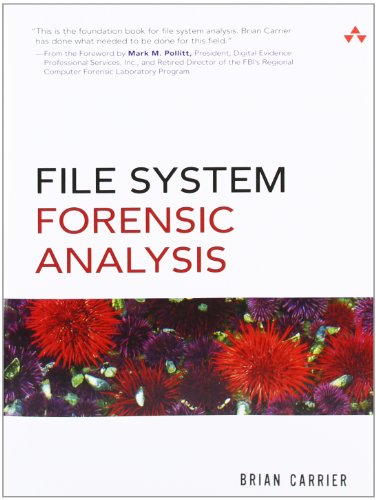File System Forensic Analysis pdf free
Par macias monica le mardi, juin 28 2016, 09:06 - Lien permanent
File System Forensic Analysis. Brian Carrier

File.System.Forensic.Analysis.pdf
ISBN: 0321268172,9780321268174 | 600 pages | 15 Mb

File System Forensic Analysis Brian Carrier
Publisher: Addison-Wesley Professional
This article dealt primarily with what we term system or file system forensics. Admin | March 20, 2013 | 27 comments |. As forensic analysts, we are providing someone with our account of a real person's actions and events. It is not the intent of this blog post to be an all-encompassing guide to the forensic analysis of an iPhone. We are telling people through our discoveries what someone did or didn't do on a particular system. This chapter breaks down a file's content and metadata. I have been spending some time reading File System Forensic Analysis by Brian Carrier which is considered by many to be the primary resource on the subject of file system forensics. Digital Forensics with Open Source Tools: Using Open Source Platform Tools for Performing Computer Forensics on Target Systems: Windows, Mac, Linux, Unix, 4) Chapter 8 on File Analysis is the longest chapter (41 pages in length), covering analysis of image files, audio and video files, archive files, and documents. I have a huge interest in file system forensics, so I have been following his Tri-Force blog posts and was anxious to hear his scheduled talk on the NTFS Logfile Forensics/Tri-Force during CEIC. Digital Evidence and Computer Crime: Forensic Science, Computers, and the Internet (File System Forensic Analysis). I'm excited to announce that my proposed tutorial on file system analysis was accepted for the 22nd Annual FIRST Conference. Back when I was first figuring out how to acquire the Samsung Galaxy Camera, I did a file system dump using Cellebrite's UFED Logical. Rather it is a look at some of the tools I use in my practice and how they can be applied to iPhone forensic analysis. Modern filesystems are highly optimized database systems that are a core function of modern operating systems. Most digital evidence is stored within the computer's file system, but understanding how file systems work is one of the most technically challenging concepts for a digital investigator because there exists little documentation. One of my peers recently wrote an article providing a good introductory explanation of computer forensics in his review of a SANS course. File System Forensic Analysis : Let's create a directory in our /root (the root user's home) directory called /root/ntfs_pract/ and place the file in there.